The 12 Best Grain-Free Dog Foods to Buy in 2024
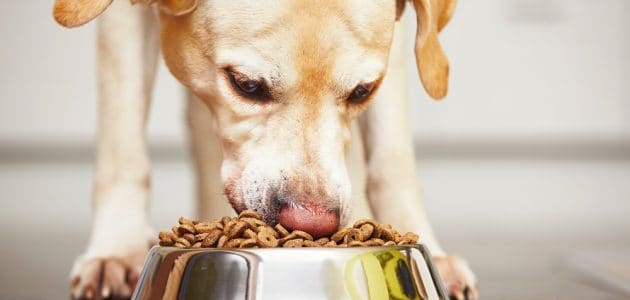
Deciding what to feed your dog isn’t just a matter of selecting the cutest pooch on the packaging. A dog’s food should be protein-rich and provide them with the well-rounded nutrition they need for a long, healthy life.
Just like with people, there are all sorts of fads and trends in food. Perhaps none has been bigger for dogs over the past decade than grain-free food. Almost every big brand today offers at least one grain-free dog food product and choosing from the array of options can be dizzying. Find out what you need to know about grain-free dog food and which products are the best of the best.
- Most Important Factors in Choosing a Grain-Free Dog Food
- Top 12 Best Grain-Free Dog Foods 2024
- 1. Best Overall: Taste of the Wild High Prairie
- 2. Best Budget Grain-Free Dog Food: Blue Buffalo Blue Wilderness
- 3. Best Premium: Cesar Variety Pack
- 4. Best for Puppies: The Honest Kitchen Dehydrated
- 5. Best for Seniors: Natural Balance Limited Ingredient
- 6. Best for Weight Management: Canidae Pure Healthy Weight
- 7. Best for Large Breeds: Taste of the Wild Pacific Stream
- 8. Best for Small Breeds: Nature’s Recipe Small Breed
- 9. Best for Multi-Dog Households: Blue Freedom Chicken
- 10. Best for Sensitive Tummies: Hill’s Science Diet Sensitive Stomach & Skin
- 11. Nature’s Recipe Easy-to-Digest Dry Food
- 12. Whole Earth Farms Grain-Free Dog Food
- Guide to Buying the Best Grain-Free Dog Food
- Grain-Free Dog Food FAQs
- Food for Thought
Most Important Factors in Choosing a Grain-Free Dog Food
Your mileage may vary, but there are several factors that you most likely will need to take into consideration before deciding which grain-free dog food is the best option for you (and your best friend).
Main Ingredients & Nutrition
With grain-free dog food, the first listed ingredient generally will be some form of protein, usually chicken but sometimes beef, fish, or something more unusual. Because grain-free dog foods don’t contain wheat, corn, soy, or other grains, vegetables and fruits are generally substituted in. So you’re likely to see ingredients like sweet potato, potato, and peas (like in this food or this one).
Grain-free foods that are heavy on carbohydrates may not provide adequate nutrition for the average dog, while some foods are specifically formulated for life stage, breed, or other considerations. This includes foods that are ideal for seniors (such as this one) or puppies (like this option).
Dog Size & Breed
As mentioned, some foods are specially formulated for particular sizes or even particular breeds. Not only does the mix of ingredients change, but the size and type of the food could change as well. After all, you can’t expect a toy breed to eat the same size kibble as a large breed, so pet parents with tiny dogs should think about feeding them tiny food (such as this one with very small kibble).
Dog Age
Senior dogs have unique nutritional and dietary needs, as do puppies, so depending on the age of your pup, you may need to consider special food for that stage of life. Many foods for older dogs are easier to digest or they may have special joint-health ingredients, while puppy food usually has ingredients to bolster healthy growth.
Allergies & Dietary Restrictions
Dogs may be allergic to specific ingredients, and grain-free foods may be available to cater to this allergy. For example, some dogs can’t digest eggs, while others may have skin allergies that can be triggered by their food. In other cases, dogs may need to lose weight or have sensitive digestive tracts that need a particular type of food.
Food Type
Dog food comes in dry or wet versions, and which is right for your pet depends on a range of factors. Many pet owners feed a combination of both, as dogs may be more drawn to wet food because of its strong scent.
Price
High-end grain-free foods will come at a premium, and for people who need a particular type of food or special ingredient, they can get even more expensive. Plus, it’s something you’ll need to buy month after month, so the costs can add up quickly, so considering a product that balances nutrition and cost might be worth it. We’ll indicate the price-point of each product in the review, whether that be lower than average ($), average ($$) or above average ($$$).
Veterinary Recommendations
Especially when switching foods for an existing dog (rather than researching options for a new best friend), be sure to consult with your veterinarian, as changing to a new food can be very upsetting for your dog (some tips on that here!). They can help you understand all aspects of your dog’s nutritional, breed, size, dietary, and other needs. They’ll also probably have their own strong opinions about which foods are best based on their experience.
With this overview in mind, let’s tuck into our list of delicious dog food. If you want more detail about what to keep in mind when purchasing grain-free dog food, we have a full guide below.
Top 12 Best Grain-Free Dog Foods 2024
1. Best Overall: Taste of the Wild High Prairie
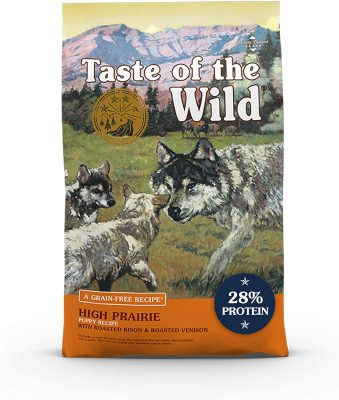
Editor’s Rating:
Why we like it: Taste of the Wild’s High Prairie formulation, which features roasted bison and venison, is a well-rounded nutritional option at a reasonable price, helping pet parents strike an ideal balance.
Quick Facts
- Food type: Dry
- Main proteins: Bison and venison
- Life stage: All
- Price: $
Key Ingredients
In addition to the main proteins offered in the High Prairie flavor, other prominent ingredients include chicken meal, sweet potatoes, peas, and potatoes. The high vegetable content could make this a less viable option for dogs who are sensitive to carbohydrates, but most other products on this list are in the same boat (this gourmet option is a major exception).
Feeding Recommendations
The food can be given to puppies, but feeding recommendations are provided for non-senior adults. A medium-sized dog weighing around 30 pounds should eat about 2 cups per day.
Value
High-protein foods often come at a premium, but this formulation was cheaper than the average price per pound among all the grain-free dog foods we reviewed, and for those who buy a 30-pound bag, the food should last quite a while.
Good to Know
Taste of the Wild’s High Prairie flavor is also sold in canned, wet versions that offer either the bison and venison flavor or switch the protein out for lamb. The dry version also made with probiotics intended to improve GI tract health. There is a puppy version too on the listing.
Pros
- High protein
- Below-average price
- 30-pound bags available
- Brand offers wet and dry types
Cons
- Relatively high carbohydrate content
- No versions explicitly made for puppies or seniors
2. Best Budget Grain-Free Dog Food: Blue Buffalo Blue Wilderness
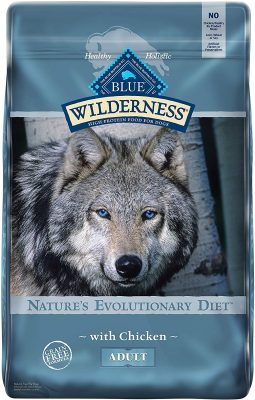
Editor’s Rating:
Why we like it: Though it lacks some of the exotic meat punch found in other grain-free foods on this list, Blue Buffalo’s Blue Wilderness chicken formulation is an ideal entry point for pet parents concerned about the cost of grain-free food.
Quick Facts
- Food type: Dry
- Main protein: Chicken
- Life stage: Adult
- Price: $
Key Ingredients
In addition to chicken as the main protein, Blue Wilderness includes peas, potatoes, and sweet potatoes to add substance. Carrots and berries add antioxidants to promote cell health.
Feeding Recommendations
A 30-pound adult dog should eat about 2 cups of this food per day, but no version of this line is specially formulated for puppies. However, water can be added to the dry kibble to soften it for growing pups.
Value
Blue Buffalo’s Blue Wilderness line isn’t the cheapest option that Blue offers, but the Blue Wilderness selection of products is the most nutritionally balanced of the affordable products we reviewed.
Good to Know
Other versions of the Blue Wilderness food are available, including versions formulated with duck or salmon, and while smaller bags are available, the 24-pound bag provides the most bang for the buck. Blue Wilderness formulations are also offered in canned versions.
Pros
- Excellent nutritional content
- Lower-than-average price
- 24-pound bags available
- Multiple flavor options
Cons
- No puppy formulation
- Limited protein options
- Not the cheapest option despite a lower-than-average price
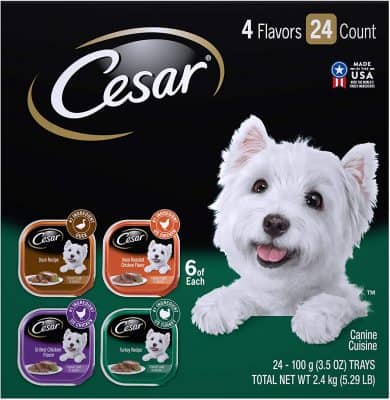
Editor’s Rating:
Why we like it: Cesar foods have long been the go-to product for especially pampered pooches, and this high-end version ensures that spoiled doggos can still jump on the grain-free bandwagon.
Quick Facts
- Food type: Wet (trays)
- Main protein: Chicken, turkey, duck
- Life stage: Adult
- Price: $$$
Key Ingredients
Cesar’s variety pack includes four formulations that offer either duck, chicken, or turkey. Beyond the protein included, few other recognizable ingredients are listed, though that’s not a knock on this product, which also includes some dried yam for bulk.
Feeding Recommendations
This isn’t recommended for puppies, as the rich content can be difficult for young dogs to digest, and even with adults, many pet parents choose to mix this food with dry kibble to make it last longer. But for adult dogs eating only this food, a 15-pound dog should eat four trays, or about 1¾ cups.
Value
This is the most expensive food on this list, which is a big reason why many of those who use it don’t feed their dogs only this, and even Cesar themselves provide instructions for how to supplement their trays with dry kibble. But the variety pack offers a lot of options, and those who are prepared to pamper their pupper by considering this food in the first place probably aren’t too concerned about the total investment.
Good to Know
Other Cesar versions include ones with steak flavors as well as versions that offer 36 trays instead of the 24 that come with this variety pack.
Pros
- Wet food that’s easy on dogs’ teeth
- Almost all the major ingredients are meat
- Versatile item for those who may want to mix in dry kibble
- One of only a few grain-free wet foods for adult dogs
Cons
- Expensive, especially when it’s the only food
- Not ideal for bigger dogs, unless mixed with kibble
- Rich content can be difficult for some dogs to digest
4. Best for Puppies: The Honest Kitchen Dehydrated
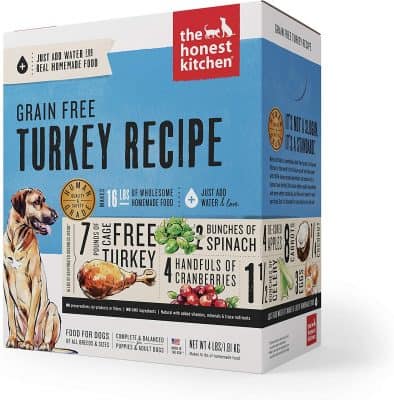
Editor’s Rating:
Why we like it: Billed as human-grade food, the Honest Kitchen’s line of dehydrated grain-free food is ideal for high-energy dogs, including puppies prone to zoomies. The high calorie content helps pups grow up strong.
Quick Facts
- Food type: Wet (dehydrated)
- Main protein: Turkey
- Life stage: All
- Price: $$$
Key Ingredients
In addition to turkey, the main ingredients include potatoes, spinach, carrots, coconut, eggs, and more dehydrated whole foods with only a handful of non-recognizable ingredients listed. All ingredients, including the protein, vegetables, and others, arrive dehydrated, and water is added to create meals.
Feeding Recommendations
Puppies of medium-sized breeds should be fed about 2 cups of dry food per day, which equates to about 3 cups once it’s mixed with water. Prepared food can be stored in the fridge for a couple of days so that you have meals ready to go.
Value
The 4-pound box of dehydrated mix makes about 16 pounds of wet dog food, so the total cost does make this product on the higher-than-average side of the price scale. But the high calorie content is ideal for getting puppies off to a good nutritional start.
Good to Know
All proteins included in the Honest Kitchen’s grain-free dog food are responsibly sourced, and the turkey flavor is made with cage-free turkeys. Similarly, versions are available with free-range chicken, ranch-raised beef, and wild-caught fish.
Pros
- High protein and high calorie content
- Few non-recognizable ingredients
- Meals can be prepared ahead of time
- All meat proteins come from responsibly sourced animals
Cons
- Above-average price
- Mixing requires waiting at least 5 minutes
- Prepared food can only be stored for 3 days at most
5. Best for Seniors: Natural Balance Limited Ingredient
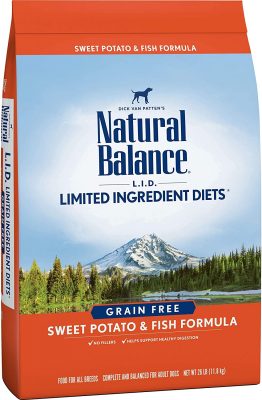
Editor’s Rating:
Why we like it: Many pet owners prefer not only to feed their dogs grain-free food but to give them food with a simplified ingredient list. Natural Balance’s limited ingredient formulation is the most well-rounded and economical version, making it best for senior dogs.
Quick Facts
- Food type: Dry
- Main protein: Sweet potato and salmon
- Life stage: Adult
- Price: $$
Key Ingredients
Other than sweet potato and salmon, almost nothing on the simplified list of ingredients is recognizable to non-scientists, with mostly vitamins and minerals added to promote optimal health and limit the possibility of bad reactions to the food, which is especially important as dogs get older and become more prone to other health issues.
That said, the first ingredient being sweet potato may be an issue for those who want a higher protein content and may prefer meat to be the No. 1 ingredient.
Feeding Recommendations
A 30-pound dog should eat about 2 cups of this food per day, and particularly for seniors with sensitive systems, pet parents should consider a couple of smaller meals instead of one large meal, as this can aid with digestion. Pet owners particularly concerned about easy digestion could consider another product on the list.
Value
The price per pound for this food was just about average compared to the others we reviewed, which helps make it an excellent option for pet owners who are interested in feeding their senior dogs a limited-ingredient diet. Multiple size options are available, with the largest coming in a 26-pound bag, meaning the food will last quite a while.
Good to Know
Other flavors are available in the Natural Balance limited-ingredient line, including potato and duck, sweet potato and bison, sweet potato and venison, and sweet potato and chicken. Natural Balance also offers similar versions designed for puppies, though only one protein (duck) is available.
Pros
- Specially formulated to be digestible
- Excellent value for the price
- 26-pound bag available
- Brand also offers versions for puppies
Cons
- Ingredient other than meat is No. 1 (sweet potato)
- Main meat (salmon) is the second listed ingredient
6. Best for Weight Management: Canidae Pure Healthy Weight
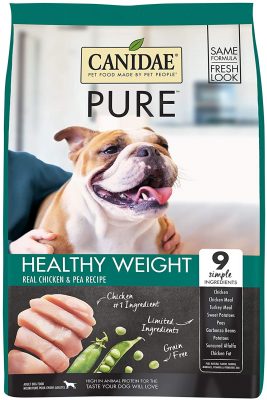
Editor’s Rating:
Why we like it: Canidae Pure’s weight-management formulation pares down the ingredient list to just nine (aside from flavoring, minerals, and vitamins) to help dogs on the heavier side boost their nutrition while reducing their calorie intake.
Quick Facts
- Food type: Dry
- Main protein: Chicken
- Life stage: Adult
- Price: $$
Key Ingredients
The weight-management version includes chicken as the main protein, and other major ingredients are limited to sweet potatoes, peas, garbanzo beans, and potatoes. The low-fat protein source is designed to help portly pups shed the unwanted (and potentially unhealthy) pounds.
Feeding Recommendations
A 30-pound adult dog should eat about 1½ cups of this food per day, combined with getting ample exercise. At a healthy pace, an overweight dog should lose about 1 to 5 pounds per month depending on their current weight. (Learn more about healthy weight in dogs.)
A 24-pound bag (the largest offered) should last quite a while, though pet owners may have a difficult time getting their dogs to take to this food, as even as dog food goes, it’s quite bland. Also, the kibble is on the larger side, which could be challenging for smaller dogs.
Value
Canidae Pure’s weight-loss formulation is designed to help your pup shed a few pounds, but it also offers a limited list of ingredients, which is a feature many other grain-free foods don’t have. Combined with a price that’s about average, that makes this an excellent value.
Good to Know
Other flavors and formulations are available, though none that are specifically for weight management, including chicken, duck, lamb, lamb, goat, and venison, salmon, and wild boar. Canidae Pure also offers two other chicken versions, one for puppies and one for seniors.
Pros
- Limited ingredient list keeps the calorie count down
- Lean protein is the main ingredient
- 24-pound bag will last a long time
- Excellent value for the money
Cons
- Bland taste may be turn-off for dogs initially
- Only one version explicitly for weight loss
- Somewhat large kibble could be a problem for small breeds
7. Best for Large Breeds: Taste of the Wild Pacific Stream
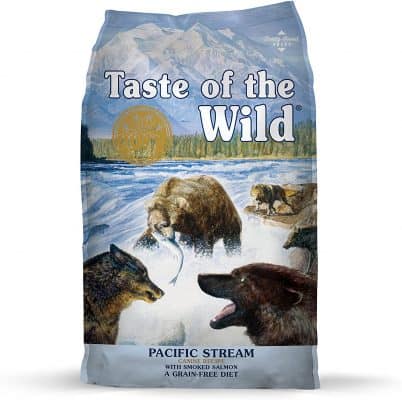
Editor’s Rating:
Why we like it: The smoked salmon flavor of Taste of the Wild’s Pacific Stream formulation amps up the lean protein, and the oversized bag makes it ideal for large breeds that go through food rapidly.
Quick Facts
- Food type: Dry
- Main protein: Salmon
- Life stage: Adult
- Price: $
Key Ingredients
After salmon, the leading ingredients include sweet potatoes, potatoes, and peas, like many other products on this list. Protein accounts for about 30% of the content in the Pacific Stream formulation, which helps large breeds build long, lean muscle. But while the formulation includes antioxidants, it isn’t heavy on vitamins and minerals to boost joint health, so for owners of large-breed dogs prone to these issues, supplements may still be necessary.
Feeding Recommendations
A 100-pound dog should eat between 6 and 10 cups of this food per day, presuming the dog is highly active. Those who aren’t as active should eat closer to 6 than 10 cups, as larger breeds can quickly pack on the pounds with lack of activity. When it comes to large dogs, carrying extra weight can tax their joints, which can be tricky to prevent given their calorie needs.
Value
The price per pound for this food is below average compared to the others on the list, and the 30-pound bag means it should last a while even with a big dog. Of course, owners of large breeds are well-accustomed to frequent food-buying, but in homes with more than one large dog, it’s not unreasonable to expect to purchase at least one bag per month.
Good to Know
Taste of the Wild also offers Pacific Stream formulations for puppies and seniors, as well as offering canned options. Additionally, this version is made without eggs. This makes it good for dogs who have allergies or sensitivities to eggs.
Pros
- Lean protein is the main ingredient
- Below-average price
- Protein is partially sustainably sourced
Cons
- Lacks joint-health-boosting nutrients
- Relatively low price, but it could be too high for multiple-dog households
- Formulation doesn’t include ingredients for weight control
8. Best for Small Breeds: Nature’s Recipe Small Breed
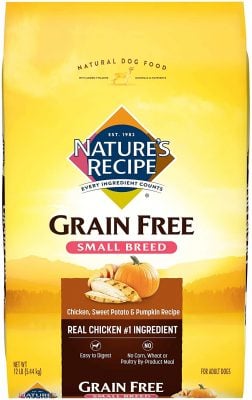
Editor’s Rating:
Why we like it: In addition to offering small kibble for the adorably tiny mouths that small-breed dogs have, Nature’s Recipe small breed formulation is made with a lean protein (chicken) to help ensure muscle and weight health.
Quick Facts
- Food type: Dry
- Main protein: Chicken
- Life stage: Adult
- Price: $
Key Ingredients
In addition to chicken, the biggest ingredients in this product are sweet potato and pumpkin, followed by garbanzo beans and peas. Nutrients and minerals like calcium, copper, and manganese help promote strong bones and joints. Many small breeds are notorious for having easily broken bones as well as other issues with joints, including hips and knees.
Feeding Recommendations
A 5-pound adult dog should eat about one-half cup of Nature’s Recipe small breed formulation per day.
Value
Many other small-breed options come in canned or wet versions (like another one on this list), which generally are more expensive than dry versions, and the relatively low price for this product could be a welcome relief for owners of small-breed dogs. A 12-pound bag should last at least a couple of months, assuming the dog is 5-8 pounds. So pet owners concerned about if their dog will like this food may want to consider the smaller 4-pound bag, which is slightly more expensive per pound.
Good to Know
Nature’s Recipe also offers grain-free canned versions, as well as grain-free tray versions for small breeds that prefer wet food, or need to be enticed to eat their kibble with wet food toppers, but the wet versions are much pricier. Nature’s Recipe also offers grain-free versions for puppies and large breeds.
Pros
- Small kibble
- Lean protein (chicken)
- Very affordable price
- Nutrition to promote bone and joint health
Cons
- Only one protein option
- 12-pound bag not advisable for picky eaters
- Wet and canned versions are much more expensive
9. Best for Multi-Dog Households: Blue Freedom Chicken
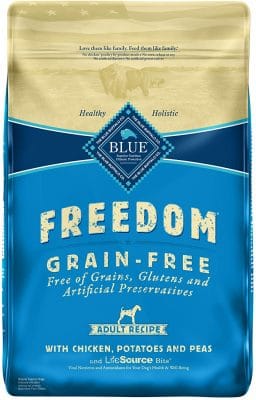
Editor’s Rating:
Why we like it: Blue Buffalo’s Blue Freedom line is ideal for households with two or more dogs who can’t afford to invest in more exotic proteins or special dietary ingredients, and the chicken version should be easily digestible for most dogs who don’t have sensitivities.
Quick Facts
- Food type: Dry
- Main protein: Chicken
- Life stage: Adult
- Price: $$
Key Ingredients
After chicken, the most prominent ingredients include peas, sweet potatoes, carrots, blueberries, and cranberries, and the mix is designed to aid digestion and appeal to as many dogs as possible.
But because this formulation is meant to have something of a mass-market appeal, it is stripped of some of the specialty aspects of other dry foods, like exotic proteins or limited-ingredient varieties, including at one food that has both!
Feeding Recommendations
A 30-pound adult dog should be fed about 2 cups of this food per day. The kibble is supplemented with nutrient-dense bits, Blue’s LifeSource bits. Particularly picky eaters may pass over the regular kibble and go straight for these tiny bits.
Value
With a price that’s just a tick over the average product we reviewed, this product is an ideal option for homes with multiple dogs that still want to be able to feed their pets a high-end grain-free food. A 24-pound bag should go a long way, even if there are two or three dogs in the house (assuming none of them are especially large). That said, homes with several big dogs likely will need to consider a much cheaper grain-free food.
Good to Know
Blue Freedom grain-free also comes in a version designed for puppies, as well as offering versions for toy, small, and large breeds, weight management, and seniors. Other flavors of the standard Blue Freedom line include beef and lamb.
Pros
- Lean protein (chicken) is the first ingredient
- Excellent value, even for homes with multiple dogs
- 24-pound bag lasts a while
- Multiple options for different breeds and life stages
Cons
- Picky eaters may become obsessed with LifeSource bits
- No specialty ingredients for joint health or weight management
- No options for exotic proteins
10. Best for Sensitive Tummies: Hill’s Science Diet Sensitive Stomach & Skin
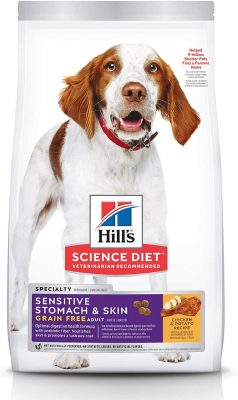
Editor’s Rating:
Why we like it: Hill’s Science Diet dry grain-free food for sensitive stomachs is ideal for pet owners whose best buddies have chronic allergies, or conditions that make them prone to vomiting or diarrhea. The price is about average compared to other grain-free foods.
Quick Facts
- Food type: Dry
- Main protein: Chicken
- Life stage: Adult
- Price: $$
Key Ingredients
A low-fat protein (chicken) is the star of the show, and Hill’s Science Diet adds other ingredients that are easy to digest, as well as those that help support gut health. Pets that are prone to skin allergies may also benefit from the addition of vitamin E and fatty acids. Pets that not only are digestively sensitive, but who also are picky eaters, may not be terribly drawn to the bland chicken flavor – so foodie dogs might need the additional enticement of toppers or a bit of water.
Feeding Recommendations
A 30-pound adult dog should eat about 2 cups of this food per day, and pet owners should break their food into multiple meals to further aid digestion. At least two meals are recommended. Toy breeds may have a challenge with this medium-sized kibble, but it’s an ideal size for most other dogs.
Value
The price of this grain-free dog food is right on the average of all products we reviewed, which is welcome news for pet parents who are concerned about their digestively troubled best friends. As mentioned, it’s on the bland side, though, so any toppers or other enticements that need to be added should be factored into the overall price.
Good to Know
Hill’s Science Diet sensitive stomach and skin is only offered with one protein option (chicken), and the adult version shouldn’t be given to puppies or pregnant dogs, as it’s a bit on the low end in terms of nutrition. Hill’s Science Diet does have sensitive formula versions for small and toy breeds, as well as canned versions.
Pros
- Special formula aids digestion
- Medium-sized kibble perfect for most dogs
- Excellent value considering added features
Cons
- Bland taste may make it unappealing for picky eaters
- Slightly light on nutrition
- Only one type of protein offered (chicken)
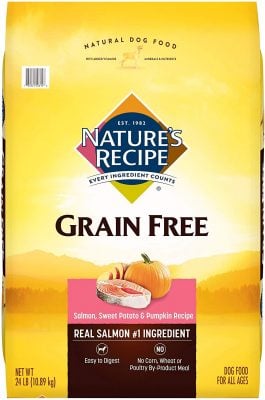
Editor’s Rating:
Why we like it: With salmon, sweet potato, and pumpkin as the main ingredients, this may be a more affordable option for pet owners who have multiple dogs with sensitive stomachs.
Quick Facts
- Food type: Dry
- Main protein: Salmon
- Life stage: Adult
- Price: $
Key Ingredients
As mentioned, the leading ingredients here are salmon, sweet potato, and pumpkin, which are all included to help ensure healthy digestion. It may not be as bland as the Hill’s Science Diet entry on this list, but like that product, it was designed to be easy on the tummy As a result, it’s not exactly bursting with flavor. The other major ingredients include garbanzo beans and peas.
Feeding Recommendations
A 30-pound adult dog should eat about 4 cups per day, and meals should be broken down into at least two or three. The food is also OK to give to puppies and pregnant or lactating dogs. The kibble is on the smaller side, so it might not be an ideal option for large breeds or households with multiple dogs of varying sizes.
Value
The price of this food is well below the average of all the grain-free foods we reviewed, which makes it a good alternative to the more expensive Hill’s Science Diet.
Good to Know
Other flavors in the easy-digestion line include chicken and lamb, and both of those also have sweet potato and pumpkin as their second and third ingredients. Easy-digestion versions are also available for large breeds and small breeds, as well as puppies, though the standard version also is OK to give young dogs.
Pros
- Low price
- Small kibble size makes it versatile enough to give to puppies
- Non-chicken protein option
Cons
- Bland taste
- Kibble size may not work for larger dogs or multi-dog houses
- No exotic protein options
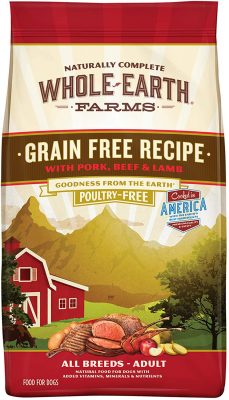
Editor’s Rating:
Why we like it: Whole Earth Farm’s grain-free food is an excellent gateway into natural and grain-free dog foods.
Quick Facts
- Food type: Dry
- Main protein: Pork, beef & lamb
- Life stage: Adult
- Price: $
Key Ingredients
The main version supplements pork, beef and lamb with potatoes, peas, sweet potatoes, and more. As a standard grain-free food for adult dogs, the ingredient list isn’t packed with specialty items that improve digestion or help shed pounds (like this one). The pork, beef, and lamb version is ideal for dogs who find chicken flavors too bland, but many pet owners may be wary of feeding their dogs pork given its high fat content.
Feeding Recommendations
A 30-pound adult dog should eat about 2 cups of food per day, assuming a typical level of activity, and athletic dogs should eat about 25% more.
Value
This food has one of the lowest dollar-per-pound price among all the foods we reviewed, and the decent range of flavors makes it an excellent option if there aren’t any dietary restrictions that need to be factored in.
Good to Know
Whole Earth Farms also offers grain-free adult versions with chicken and turkey, salmon and whitefish, or turkey and duck, and small-breed and puppy foods are also available from the brand. The kibble is medium-sized, which could be challenging for small breeds or puppies.
Pros
- Excellent value
- Meets basic nutritional content standards
- Though they’re limited, protein options are available
- Formulas and flavors for small breeds and puppies are offered
Cons
- Medium-sized kibble likely won’t work for houses with small dogs
- No special dietary considerations or ingredients
- Only a few proteins offered
Guide to Buying the Best Grain-Free Dog Food
What to feed your dog is no small consideration, so it’s no surprise that there are big questions to have answered and issues you need to understand before making your decision. Follow our guide to help you understand what you need to know about grain-free dog food so you can make the healthiest choice for your furbabies.
Changing Dog Foods
For most dog owners, once they find a food that works, they stick with it – and for good reason. That’s because an abrupt change in food can wreak havoc on a dog, potentially even making them sick enough that they need to see the vet. Even dogs without food sensitivities can experience vomiting, decreased appetite, and diarrhea after a sudden food change.
Any food switch should be done gradually. Here’s a good rule of thumb from the American Kennel Club about making the change to a new grain-free dog food over a weeklong period, which we’ll summarize here:
- Day 1: 25% new food, 75% old food
- Day 2: Repeat
- Day 3: 50% new food, 50% old food
- Day 4: Repeat
- Day 5: 75% new food, 25% old food
- Day 6: Repeat
- Day 7: 100% new food
If your dog is sensitive, has allergies, or has a history of digestive problems, you may need to be even more gradual than the seven-day switch schedule proposed here. Note any changes in your dog, including digestive, skin, or behavioral shifts, and consider slowing or stopping the transition and consult with your vet if you are concerned.
Grain-Free Dog Food Explained
Human food trends often show up a few years later in what we feed our pets, and the same is true with grain-free dog food. The low-carb, high-protein trend (including the move toward gluten-free foods) is mirrored in the rising popularity of grain-free dog food.
Grain-free dog food expanded its share of all dog food purchases by more than 171% percent between 2012 and 2016. Unlike traditional dog foods, grain-free dog foods are made without wheat, corn, rice, or other grains. In most cases, alternative carbohydrates are substituted, such as potatoes, sweet potatoes, and peas.
Pros and Cons of Grain-Free Dog Food
While there certainly are many positive aspects to grain-free dog food, not every facet of this type of food is positive. Here’s a look at some of the pros and cons of buying grain-free dog food for your pets:
Pros
- High protein content
- Usually contain higher-quality ingredients
- Lack of fillers
Cons
- Cost and availability
- Often offers less-balanced nutrition
- Some include carbohydrate sources with high starch content, which can promote weight gain
Grain-Free Concerns
Many dog owners were disturbed a couple of years ago when the Food and Drug Administration announced it was investigating a possible connection between grain-free dog food and heart disease.
The agency has not indicated that a clear link exists between grain-free foods and heart problems in dogs, but the evidence was terribly worrying: About 90% of dogs reported to have a heart condition called dilated cardiomyopathy (DCM) were eating grain-free food, and a similar percentage ate diets that contained peas and/or lentils. But it should be noted that the dogs in those cases ate only that food, and some of the dogs were from breeds predisposed to the condition.
Still, with no clear link between grain-free foods and DCM in dogs, it’s best to consult your veterinarian if you have concerns about your pet, rather than considering avoiding all grain-free foods, even those that are well-balanced nutritionally.
Alternatives to Commercial Dog Foods
While you can’t feed your dog table scraps, it may be possible to feed a dog many of the same types of foods you eat, though special considerations exist. For those who may be interested in avoiding commercial dog foods while feeding their pets a grain-free diet, homemade dog food could be a good alternative, though there are some quite affordable options on this list (especially this one and this one).
Many foods on our list are filled with ingredients that you probably have in your kitchen right now: chicken, beef, salmon, carrots, green beans, apples, eggs, and more.
Balance is important, so any homemade dog food recipe should include a quality protein source (beef, chicken, eggs, fish, and liver are all dog-approved proteins), a fat source (olive oil, canola oil, or fish oil), fiber-rich carbohydrates (for those avoiding grains, sweet potato is a good carb), and fruits, vegetables, or herbs.
Dogs, of course, don’t have the same nutritional requirements that humans do. The biggest example of this is calcium. People need calcium, too, but for dogs, calcium is even more critical, so for those considering a homemade dog food recipe, calcium tablets would likely need to be incorporated.
Consider, though, that your dog will need to eat a certain amount of calories per day to sustain health, and if you were feeding them twice a day with commercial food, you’ll probably need to prepare at least that many homemade meals if not more, since your homemade food will have fewer filler ingredients that add to the calorie count. Learn more about homemade dog food in this article from the AKC.
Factoring in Your Dog’s Unique Needs
Your specific dog’s needs are the most important things to consider when picking a dog food, regardless of the composition or ingredients that the food has. Let’s take a closer look at how factors related to your dog can influence their dietary needs.
Age
Food that’s great for puppies may not be so great for senior dogs. With a puppy, the concern isn’t getting them to eat (because they’ll do that pretty much all the time), but it’s making sure they are getting a nutrient-dense diet so that they can grow up strong and healthy. Here’s a look at how a dog’s dietary needs change over its life:
Puppy
Just as human babies need foods that make their brains and bodies grow quickly, so do baby dogs. Growing puppies need food with more calories per serving and more nutrients, fat, and protein than adult dogs. In general, dogs stay in this phase of their dietary life until 1 year of age.
Young Adult to Middle Age
As long as there aren’t any health problems or allergies, most adult dogs (between 1 and 7 years of age) don’t really need special dietary considerations, and foods that have lots of nutrients and are well-balanced in terms of protein, fat, and vitamins will keep an adult dog happy and healthy.
Senior
Older dogs (8 years and up) tend to be less active than their younger counterparts, so they may need a boost of protein to help them stave off weight gain while still eating the same number of calories. Also, dogs in this age group are more likely to have chronic health problems that can sometimes be helped by feeding them a great diet.
Breed
While a Pomeranian and a Mastiff could each be perfectly healthy eating exactly the same food, they are very different dogs, and optimizing their health may mean selecting a particular food based on their breed.
In some cases, foods can be tailored to behavioral quirks often present in one breed or another. For example, Labradors are notorious food-scarfers, and foods designed for them will often come with specially shaped kibble meant to eat more slowly.
Size
Breed-related food differences will most often come down to size rather than behavioral or health quirks. Larger dogs are more slow-moving, and they expend less energy to move the same distance as a smaller dog. But with their larger size, they will need more calories to function properly.
Researchers recommend that an inactive 30-pound dog consume 674 calories per day, compared with 2,100 calories per day for an active 90-pound dog.
Health
In some cases, grain-free dog foods can help manage health issues in dogs, including digestive problems, allergies, joint health, and more. But the choice of dog food and how much to feed them could also be impacted by sickness or surgery.
Dogs that are recovering from trauma like a surgery will probably need to eat foods that are higher in fat while they convalesce. Feeding a more fat-rich diet allows the dog to get the calories and energy it needs while eating less food, which will probably make him more comfortable – depending on the nature of his surgery.
If this applies, be sure to consult with your veterinarian before making any decisions on what to feed your dog after surgery.
Number of Dogs
Beyond each individual dog, it’s important to consider if the food will need to provide nutrition to multiple dogs. If so, unless the dogs are wildly different sizes or have unique nutritional concerns, it’s likely you’ll be able to feed them all the same food.
This is certainly easier with dogs of the same breed and roughly (ruff-ly?) the same size, but consider a medium-sized dry food that has an easily digested common protein, like chicken, as this should appeal to most dogs. A product like this is helpful in a multi-dog household.
Treats
Not all dog treats are grain-free, so if your plan is to make sure your dog doesn’t eat grains, you’ll need to closely examine ingredients in their treats as well. But regardless of what’s in the treat, the calories in each treat your dog gets every day should be factored into the amount and type of food they’re getting.
Healthy Weight
Like with people, carrying around extra weight can be a drag on overall health. Dogs that are overweight by as little as 5 pounds could be an elevated risk of early death, joint problems, diabetes, heart disease, and more. So, if you notice your dog is on the plumper side, a food specially formulated for weight loss may be helpful.
A safe rate of weight loss for most dogs is 1-5 pounds per month, or about 3-5% of bodyweight lost per month, depending on their size and ideal weight.
Grain-Free Dog Food FAQs
Here’s a look at some of the most frequently asked questions about grain-free dog food:
Does My Dog Need to Eat a Grain-Free Diet?
In short, a diet reliant on grains is probably not good for either you or your dog’s health, and rising rates of overweight-related health issues point to this being the case.
So, if you are interested in eating less of this starchy, filler-laden food for your own health, shouldn’t it stand to reason that your dog’s health could also be improved?
Additionally, as with humans, some dogs do have difficulty digesting grains or may even be allergic to them.
What Meats Do Dogs Like?
If your dog is like most, they’ll eat pretty much any type of meat. But balance is important in a dog’s diet, as in a human’s. Generally though, dogs require more protein per serving than humans.
So lean proteins like chicken or turkey, as well as more fat-rich ones like beef or liver, should be the foundation of a dog’s diet, assuming they don’t have underlying health issues that would keep them from eating any of those foods.
Are Eggs Good for Dogs?
Usually, yes. In fact, many veterinarians prescribe a diet of eggs, cottage cheese, and rice for dogs who are in acute intestinal distress. Eggs are an excellent source of protein and are usually rich in amino and fatty acids.
However, some dogs are allergic to eggs, so be sure to monitor your dog’s reaction to any foods containing eggs if you think they could be allergic.
Can Dogs Eat Vegetables?
There are many vegetables that are as beneficial for dogs as they are for humans, and most grain-free foods include at least a few of them. This could include things like potatoes, carrots, green beans, sweet potatoes, and peas, all of which are quite common in grain-free foods.
But pet owners could consider giving some less-obvious veggies to their dogs, either as additives in their food or as a treat, including cucumber, broccoli, cauliflower, and asparagus.
Dogs should never be given onions, mushrooms, leeks, chives, avocado, or garlic, as they all are toxic to dogs.
Is Wet Food Better Than Dry Food?
There is no single answer to this. But it’s important to note that dry food is generally cheaper, though canned wet food and regular dry food both have a similar shelf life. Canned wet food also has a higher moisture content, which can leave your dog hungry even though he recently ate.
Also, dry dog food can help remove tartar from your dog’s teeth, while most wet foods don’t have any solid bits that can help with dental health.
How Can I Keep My Dog From Scarfing Down Their Food?
In addition to sounding gross, rapidly wolfing down food can be dangerous for your pet. Dogs who scarf down food also take in large amounts of air as they take in the food, and that air can travel into their stomach and digestive tract, making them sick.
There are many specially designed anti-scarfing bowls, but a more economical solution may be to place a smaller bowl upside-down inside a larger bowl and pour the dog’s food around the smaller bowl. The goal is to force her to eat more slowly.
Food for Thought
You take great care in making sure your dog is as happy and healthy as possible, and choosing the best food is no different. While they certainly aren’t for every single dog, the variety of grain-free dog food options means most dogs can benefit from one of the products on our list. And, hey, if your best friend needs to taste-test a few different finalists, he probably won’t mind.




